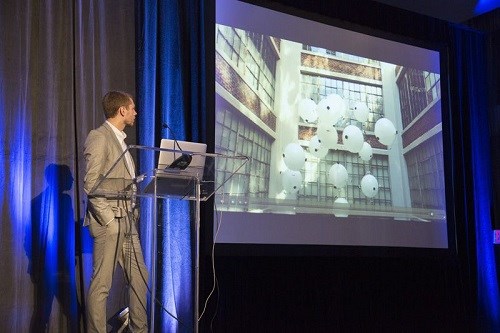The Promise of "4D Printing"
MIT scientist is shaping the next development to 3D printing: 4D printing, where the fourth dimension is time.

In terms of the “wow factor” at the recent GPS2015, co-hosted by IHS Chemical and SPI, I’d say the starring role perhaps belonged to Skylar Tibbits who was the innovation keynote speaker of the session “Glimpse into the Future: The Next Generation of Plastics.”
Director/research scientist of the Self-Assembly Lab at MIT’s Dept. of Architecture, Tibbits has been leading a unique research collaboration between MIT and the education and R&D departments of Stratasys, which promises to shape the next development to 3D printing. Coined and popularized by Tibbits with numerous TED Talks over the last five years, 4D printing--whereby the fourth dimension is time—refers to his group’s research that promises to revolutionize material form and control. It will allow the printing of items that adjust themselves and self-assemble over time in order to accommodate changing physical conditions, or to repair themselves. As such, it has the potential to have an enormous impact on a host of different market sectors-- from healthcare, to construction and infrastructure, to aerospace and automotive, to packaging and consumer products.
Stratasys’ Objet Connex multi-material 3D printing technology has been an important part of Tibbits’s 4D research. With Connex technology, a single print with multi-material features can transform from any 1D strand into 3D shape, 2D surface into 3D shape or morph from one 3D shape into another. Researchers can program different material properties into each of the various particles of the designed geometry and harness the different water-absorbing properties of the material to activate the self-assembly process.
With water as its activation energy, this technique promises new possibilities for embedding programmable and simple decision making into non-electronic based materials. Imagine robotics-like behavior, says Tibbits, but without the reliance on complex electromechanical devices. “Self-assembly is a process by which disordered parts (no humans, no machines) can assemble themselves—random energy produces non-random results.”
Tibbits says they have aimed to form new programmable, reconfigurable materials—strands, sheet, extrusions—and activate them to change—mechanically transform. “We’re trying to demonstrate that any fundamental material—including varying kinds of plastics, carbon fibers, textiles, wood, glass--can be a smart material.” He says nearly every material can be programmed to promote forming, curling or, as the researchers say, self-morphing.
Tibbits gave a recent ‘morphing’ example of the latest rendition of the BAC Mono super car—by England’s Briggs Automotive Company (BAC)..a car that provides a glimpse into the future of custom automotive manufacturing. “They wanted to morph a rear wing of the vehicle to allow for an autonomous way to control air flow. This was accomplished by 3D printing a single sheet of carbon fiber with polymers that promote moisture—essentially, the component is activated by responding to rain.”
In addition to automotive, aerospace (his group is currently working with Airbus), and self-forming large architectural structures, he also sees lots of scenarios for new packaging with this highly-advanced technology—smart, active packaging that can self-form and would support recyclability/sustainability, such as using agitation to assemble and methods to dissolve for disposal. Similarly, he sees this technology being used to make various self-forming consumer products. Imagine having a pair of shoes that actively change to fit the environment!
Now a ripe 30-yr old, Skyler Tibbits was awarded a TED2012 Senior Fellowship, a TED 2011 Fellowship, and was named a Revolutionary Mind in SEED Magazine’s 2008 Design issue.
Related Content
Polyethylene Fundamentals – Part 4: Failed HDPE Case Study
Injection molders of small fuel tanks learned the hard way that a very small difference in density — 0.6% — could make a large difference in PE stress-crack resistance.
Read MoreFirst Quarter Looks Mostly Flat for Resin Prices
Temporary upward blips don't indicate any sustained movement in the near term.
Read MoreFundamentals of Polyethylene – Part 3: Field Failures
Polyethylene parts can fail when an inappropriate density is selected. Let’s look at some examples and examine what happened and why.
Read MoreFundamentals of Polyethylene – Part 6: PE Performance
Don’t assume you know everything there is to know about PE because it’s been around so long. Here is yet another example of how the performance of PE is influenced by molecular weight and density.
Read MoreRead Next
Lead the Conversation, Change the Conversation
Coverage of single-use plastics can be both misleading and demoralizing. Here are 10 tips for changing the perception of the plastics industry at your company and in your community.
Read MoreFor PLASTICS' CEO Seaholm, NPE to Shine Light on Sustainability Successes
With advocacy, communication and sustainability as three main pillars, Seaholm leads a trade association to NPE that ‘is more active today than we have ever been.’
Read MoreRecycling Partners Collaborate to Eliminate Production Scrap Waste at NPE2024
A collaboration between show organizer PLASTICS, recycler CPR and size reduction experts WEIMA and Conair will seek to recover and recycle 100% of the parts produced at the show.
Read More


















 (2).jpg;maxWidth=300;quality=90)







